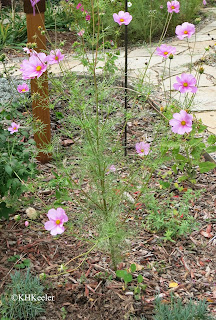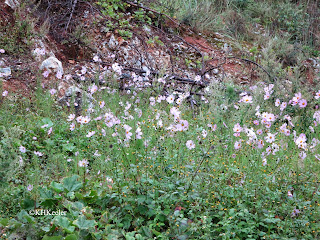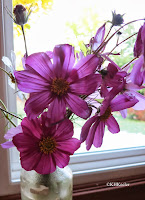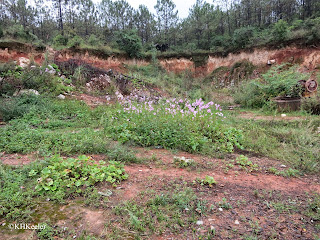 |
| garden cosmos, Cosmos bipinnatus |
 |
| garden cosmos |
Cosmos, Cosmos bipinnatus, is native to Mexico and intolerant of frost so it is grown as an annual. Cosmos bipinnatus is called common cosmos, garden cosmos or Mexican aster, and it is related to asters and dahlias (sunflower family, Asteraceae). In my yard, garden cosmos make lots of seeds and some of those survive to come up in odd places in my yard far from the original flowerbed. So I often get lots of big semiwild cosmos wherever I don't weed them out. And since I like them, that means in many spots in my yard.
 |
| garden cosmos |
The USDA plants website lists it as a non-native plant that is found in more than half the states in the US, suggesting it has naturalized in some places.(map) The Invasive Plants Atlas shows a map of places which probably have too many garden cosmos. (map of places reporting garden cosmos as invasive)
 |
| garden cosmos, Yunnan, China |
In Yunnan, in southwestmost China, garden cosmos has clearly escaped and become a weed. A pretty weed, it made a wonderful splash of color on the hillsides when I was there in September.
(You never know when or where you'll encounter a familiar plant!)
Cosmos is a attractive and relatively easily eradicated if you don't want it, so while one might wish for big stands of equally pretty native plants, cosmos is a rather benign exotic invader.
And here's a picture from 2011, reminding me as I am bemoaning the end of summer flowers, that next summer there will almost surely be more cosmos in my garden.

Has garden cosmos escaped onto roadsides and waste places where you live?
Comments and corrections welcome.
Kathy Keeler, A Wandering Botanist

Has garden cosmos escaped onto roadsides and waste places where you live?
Comments and corrections welcome.
Kathy Keeler, A Wandering Botanist
More at awanderingbotanist.com
Join me on Facebook


Not quite... a little too dry here, soil is very sandy and has to compete with much more vigorous grasses and weeds. (1/2 hour east of North Platte). The truly damaging invader here is the Russian olive tree, a pestiferous non-native plant if ever there was one.
ReplyDelete